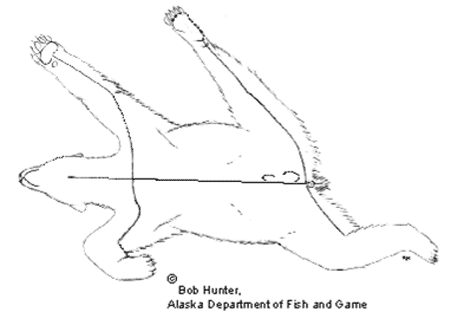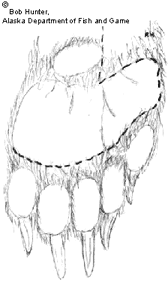Online Bear Baiting Clinic
Hide and Meat Care
Congratulations! You now have your bear down and it’s time to take care of your trophy and meat. (Note: For meat salvage requirements, see the "Rules and Requirements" section of this website.) As soon as possible, remove the hide and viscera (guts, heart, lungs) so the meat can cool quickly. Regardless of whether or not you plan to have the hide mounted, you must leave evidence of sex (penis sheath or vaginal orifice) naturally attached to the hide.
The key words to remember when working with game meat or the hide are clean, cool, and dry. Place a tarp on the ground under the bear when skinning and quartering. Have quality game bags available and immediately place the meat and hide in them. Hang the filled bags in a shaded location with good air circulation, and process the meat as soon as possible upon your return from the field. Never place your meat in plastic bags because plastic retards cooling and drying, which can hasten decomposition. See below for further information on hide care.
If you plan on having a rug or mount made out of your bear hide, you most definitely should visit your taxidermist before the hunt. Provided below is some very basic information about the initial cuts you’ll need to make on your bear carcass. Make your preliminary cuts along the lines indicated. These lines generally correspond to those locations where the hair begins pointing in different directions. [Remember, in most areas of the state you are required to leave evidence of sex (penis sheath, vaginal orifice) attached to the hide. Be sure to check current year regulations for your specific hunt area.]

Cut around the pads of the feet to the edge of the hair line, as indicated by the dotted line. In most parts of the state, the claws must remain attached to the hide when it is presented for sealing.

Hide Care
Keep the hide clean, cool, and dry. Flesh and salt the hide as soon as possible after skinning your trophy. If you intend to freeze the hide soon, do not salt it. If you will be in the field for a number of days or won’t get the hide to a taxidermist within a day or two of harvest, you should also understand how to turn the ears, split the lips, and remove each foot down to the final knuckle, nearest the claw. Be sure to have enough salt to pack into each paw area, around the ears and nose, and over the entire hide. Never store your hide in a plastic bag; the exception is that, if the hide has been cooled and salted, you will need some type of protective bag or container if shipping or air transportation is involved.
Meat Care at Home
Spring black bear meat is very edible and provides the hunter with high-quality, fresh game meat after the long winter months. Cool your bear meat for 24 hours and then process it. There is no benefit to aging bear meat longer than 24 hours. It is very important to thoroughly cook bear meat until gray in color but do not cook in a microwave. Trichinosis is a common disease found in some bears, and this parasite can cause serious problems in humans. These problems include gastrointestinal problems, headaches, nausea, and fever. Be sure to use a meat thermometer when cooking bear meat, and ensure the meat reaches an internal temperature of 150-160 degrees Fahrenheit. Freezing bear meat is not a guaranteed method to kill the parasite unless you combine very cold freezer temperatures and duration. Meat processors suggest at least 30 days in a freezer at -10 degrees Fahrenheit.
